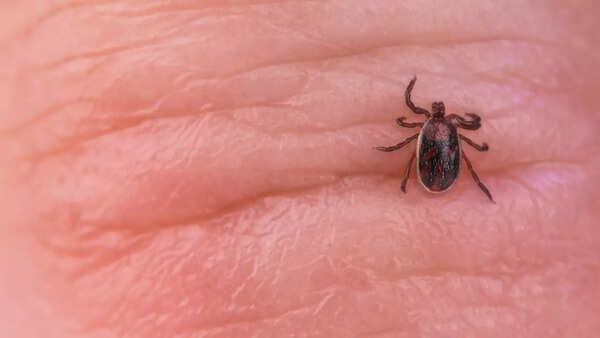Maria Palen, a vibrant 31-year-old chemical engineer from California, embodied the image of a fitness guru. With a dedicated following of over 20,000 on Instagram, she inspired many with her plant-based diet and consistent exercise routine. However, her journey took a dramatic turn when she was diagnosed with babesiosis, a parasitic infection transmitted through tick bites, leading to paralysis from the waist down by late 2024.
 *Image credit: Instagram/planthlete_maria*
*Image credit: Instagram/planthlete_maria*
Maria's ordeal highlights a crucial message: outward appearances can be deceiving, and unseen health threats can silently undermine even the most robust individuals. Her story serves as a stark reminder of the hidden dangers lurking in nature, particularly those associated with tick-borne illnesses.
Initially, Maria experienced mild symptoms: inflammation, joint discomfort, and persistent thumb pain. Attempting to address these issues holistically, she adjusted her diet and intensified her exercise regimen. However, instead of improving, her condition worsened. By March 2024, she was largely confined to bed, struggling with everyday tasks.
Eventually, a functional medicine specialist identified the culprit: babesiosis. This lesser-known tick-borne disease, caused by Babesia parasites that invade red blood cells, often goes undetected due to its symptoms mimicking common ailments like the flu or fatigue. The Centers for Disease Control and Prevention (CDC) reports a doubling of babesiosis cases in the past decade, rising from 1,000 in 2011 to approximately 2,500 annually.
Maria suspects the initial tick bite occurred years prior, potentially during an outdoor hike, and went unnoticed. The infection gradually progressed, ultimately impacting her nervous system. By October 2024, severe tailbone pain prevented her from sitting, leading to the onset of paralysis.
Tick bites are often inconspicuous – small, painless, and easily overlooked. The prolonged dormancy of some infections adds to the concern. Maria's experience isn't due to negligence, but rather underscores the limited awareness surrounding less common tick-borne diseases like babesiosis.
Ticks are most active during warmer months, thriving in grassy and wooded environments. The 2024 tick season in the US was particularly severe, with milder winters contributing to increased survival rates among tick-hosting animals. Researchers at the University of California, Riverside, warn that this surge in tick populations elevates the risk of these rare infections spreading unnoticed.
The microbes responsible for babesiosis (Babesia microti and B. duncani) are difficult to detect as they reside within red blood cells. Recent research into the genome of B. duncani reveals similarities to the malaria parasite, explaining the initial flu-like symptoms such as fever, chills, and muscle aches that precede more severe complications.

Maria's story is one of resilience in the face of adversity. Despite undergoing extensive therapy, she remains optimistic about regaining the use of her legs. Her experience emphasizes the critical importance of early detection.
While doctors often test for Lyme disease when tick-borne illnesses are suspected, babesiosis is not always considered. Given the potential for co-infection with Lyme disease, symptoms may be misattributed. It is crucial for healthcare providers to adopt a broader diagnostic approach and for individuals to be vigilant about unexplained changes in energy levels, muscle strength, or persistent pain, especially after spending time outdoors.
The risk extends beyond hiking and camping. Even gardening in overgrown backyards or walking through wooded areas can pose a threat, particularly without protective clothing or tick repellents.
While standard advice includes wearing long sleeves and checking for ticks, Maria’s case calls for more comprehensive measures:
This article is intended for informational purposes only and does not substitute professional medical advice. Consult a healthcare provider for any symptoms or health concerns.
Newer articles
Older articles
 Smith Eyes Grenada Test Return After Injury Recovery
Smith Eyes Grenada Test Return After Injury Recovery
 Google Maps Boosts Navigation Precision with Fused Orientation Provider Update
Google Maps Boosts Navigation Precision with Fused Orientation Provider Update
 Earth Sciences Minister Rijiju Expresses Frustration Over Atos Supercomputer Delay, Jeopardizing Weather Forecast Upgrades
Earth Sciences Minister Rijiju Expresses Frustration Over Atos Supercomputer Delay, Jeopardizing Weather Forecast Upgrades
 Washington Freedom Snatch Last-Ball Win Over Knight Riders in MLC Thriller; Playoff Hopes Soar
Washington Freedom Snatch Last-Ball Win Over Knight Riders in MLC Thriller; Playoff Hopes Soar
 East Africa Rift: Mantle Upwelling Drives Birth of New Ocean, Study Finds
East Africa Rift: Mantle Upwelling Drives Birth of New Ocean, Study Finds
 Colon Cancer: Don't Ignore These 5 Subtle Warning Signs
Colon Cancer: Don't Ignore These 5 Subtle Warning Signs
 Prasidh Krishna Vows to Sharpen Bowling After Costly Leeds Performance
Prasidh Krishna Vows to Sharpen Bowling After Costly Leeds Performance
 Gavaskar Urges India to Replace Thakur with Yadav for Second Test Against England
Gavaskar Urges India to Replace Thakur with Yadav for Second Test Against England
 Rishabh Pant's Unconventional Batting Style Is Revolutionizing Cricket, Says Greg Chappell
Rishabh Pant's Unconventional Batting Style Is Revolutionizing Cricket, Says Greg Chappell
 Vitamin B12 Deficiency: Cardiologist Explains Symptoms, Sources, and Why You're Always Tired
Vitamin B12 Deficiency: Cardiologist Explains Symptoms, Sources, and Why You're Always Tired